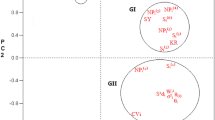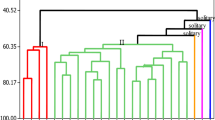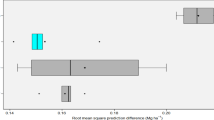Abstract
The genotype × environment interaction (GEI) have direct impact on stability of genotypes grown under varied environmental conditions. In the present study, the additive main effects and multiplicative interaction (AMMI) model was employed to investigate GEI, stability and adaptation of a worldwide germplasm of safflower (Carthamus tinctorius L.) for seed and oil yield. The experiments were conducted at seven environments (combination of location, year and irrigation regimes) using 100 safflower genotypes. The results of the AMMI analysis showed that the main effects due to genotype, environment, and GEI as well as the first four interaction principle component axes were significant for both seed and oil yield. Environment was the major source of variability, followed by GEI. The results of AMMI biplot and stability parameters including AMMI stability value (ASV), sum of the absolute value of IPC scores (SIPC) and genotype selection index (GSI) revealed that genotypes G60 (originating from Jordan) and G90 (originating from Kerman, Iran) had general adaptation under drought and normal conditions. Genotype G21, originating from Greece, exhibited high adaptation and yield under the normal environments. The AMMI biplot determined genotypes G65 (originating from USA) and G40 (originating from Tajikistan) as the superior to be grown under drought stress conditions. The results eventually indicated that the AMMI biplot is an informative method to explore the stability and adaptation patterns of genotypes in practical plant breeding.




Similar content being viewed by others
References
Abdulahi A, Pourdad SS, Mohammadi R (2009) Stability analysis of seed yield in safflower genotypes in Iran. Acta Agron Hungarica 57(2):185–195
Ahmadi A, Mohammadi A, Najafi Mirak T (2012a) Targeting promising bread wheat (Triticum aestivum L.) lines for cold climate growing environments using AMMI and SREG GGE biplot analyses. J Agric Sci Tech 14:645–657
Ahmadi J, Vaezi B, Fetokian MH (2012b) Graphical analysis of multi-environment trials for barley yield using AMMI and GGE-biplot under rainfed conditions. J Plant Physiol Breed 2(1):43–54
Allen RG, Pereira LS, Raes D, Smith M (1998) Crop evapotranspiration: guidelines for computing crop requirements. FAO Irrig Drain Pap 56:41–51
Anandan A, Sabesan T, Eswaran R, Rajiv G, Muthalagan N, Suresh R (2009) Appraisal of environmental interaction on quality traits of rice by additive main effects and multiplicative interaction analysis. Cereal Res Comm 37(1):139–148
Ashrafi E, Razmjoo K (2010) Effect of irrigation regimes on oil content and composition of safflower (Carthamus tinctorius L.) cultivars. J Am Oil Chem Soc 87(5):499–506
Brar KS, Manhas S, Hegde DM (2012) GGE biplot analysis visualization of mean performance and stability for seed yield in safflower (Cartamus tinctorus) at divers locations in India. Int J Agric Sci Res 2:77–90
Chinnusamy V, Xiong L, Zhu J (2005) Use of genetic engineering and molecular biology approaches for crop improvement for stress environments. In: Ashraf M, Harris PJC (eds) Abiotic stresses, plant resistance through breeding and molecular approach. Haworth Press, Binghamton, pp 47–89
Comstock RE, Moll RH (1963) Genotype × environment interactions. In: Hanson WD, Robinson HF (eds) Statistical genetics and plant breeding. NAS-NRC, Washington DC
Derakhshan E, Majidi MM, Sharafi Y, Mirlohi A (2014) Discrimination and genetic diversity of cultivated and wild safflowers (Carthamus spp.) using EST-microsatellite markers. Biochem Syst Ecol 54:130–136
Ebdon JS, Gauch HG (2002) Additive main effect and multiplicative interaction analysis of national turfgrass performance trials: interpretation of genotype × environment interaction. Crop Sci 42:489–496
Elfadl E, Reinbrecht C, Frick C, Von S, Rudolphi S (2005) Genotype by environment interaction in safflower grown under organic farming system. 6th int safflower conf Turkey: 236–241
Elfadl E, Reinbrecht C, Claupein W (2012) Safflower (Carthamus tinctorius L) as a new oil crop in organic farming system: potential and stability in central Europe. Int J Agric Sci 2(6):477–495
Farshadfar E, Mahmodi N, Yaghotipoor A (2011) AMMI stability value and simultaneous estimation of yield and yield stability in bread wheat (Triticum aestivum L.). Aust J Crop Sci 5(13):1837–1844
Gauch HG (2006) Statistical analysis of yield trials by AMMI and GGE. Crop Sci 46:1488–1500
Gauch HG, Zobel RW (1988) Predictive success of statistical analysis of yield traits. Theor Appl Genet 76:1–10
Gheysari M, Mirlatifi SM, Bannayan M, Homaee M, Hoogenboom G (2009) Interaction of water and nitrogen on maize grown for silage. Agric Water Manag 96:809–821
Gower JC (1967) Multivariate analysis and multivariate geometry. Statistician 17:13–28
Institute SAS (2004) SAS software version 9. SAS Institute, Cary
IRRI (2007) CROPSTAT Version 6.1. International rice research institute, Los Bańos, Philippines
Jamshidmoghaddam M, Pourdad SS (2013) Genotype × environment interactions for seed yield in rainfed winter safflower (Carthamus tinctorius L.) multi-environment trials in Iran. Euphytica 190:357–369
Jamshidmoghaddam M, Eskandari Torbaghan M, Mirzaee A (2014) Analysis of genotype × environment interaction for seed yield in spineless safflower (Carthamus tinctorius L.) genotypes. Crop Breed J 4(1):47–56
Kang MS (1993) Simultaneous selection for yield and stability in crop performance trials: consequences for growers. Agron J 85:754–757
Kar G, Kumar A, Martha M (2007) Water use efficiency and crop coefficients of dry season oilseed crops. Agric Water Manag 87(1):73–82
Khalili M, Pour-Aboughadareh A (2016) Parametric and non-parametric measures for evaluating yield stability and adaptability in barley doubled haploid lines. J Agric Sci Tech 18:789–803
Knowles PF (1969) Centers of plant diversity and conservation of crop germplasm: safflower. Econ Bot 23:324–329
Magari R, Kang M (1993) Genotype selection via a new yield stability statistic in maize yield trials. Euphytica 70:105–111
Majidi MM, Zadhoush S (2014) Molecular and morphological variation in a world-wide collection of safflower. Crop Sci 54:2109–2119
Majidi MM, Tavakoli V, Mirlohi A, Sabzalian MR (2011) Wild safflower species (Carthamus Oxyacanthus Bieb.): a possible source of drought tolerance for arid environments. Aust J Crop Sci 5(8):1055–1063
Mc William JR (1989) The dimensions of drought. In: Baker FWG (ed) Drought resistance in cereals. CAB Inter, Wallingford, pp 1–11
Mortazavian SMM, Nikkhah HR, Hassani FA, Sharif al Hosseini M, Taheri M, Mahlooji M (2014) GGE biplot and AMMI analysis of yield performance of barley genotypes across different environments in Iran. J Agric Sci Tech 16:609–622
Mundel HH, Bergman JW (2009) Safflower. In: Vollmann J, Rajcan I (eds) Oil crop, Hand book of plant breeding. Springer, New York, pp 423–448
Mundel HH, Ifuang HC, Burch LD, Kiehn F (1995) Saffire safflower. Can J Plant Sci 65:1079–1081
Mungomery VE, Shorter R, Byth DE (1974) Genotype × environment interactions and environment adaptation. I. pattern analysis-application to soybean population. Aust J Agric Res 25:59–72
Omidi Tabrizi AH (2000) Correlation between traits and path analysis for grain and oil yield in spring safflower. Sesame Safflower Newsl 15:78–83
Omidi Tabrizi AH (2006) Stability and adaptability estimates of some safflower cultivars and lines in different environmental conditions. Agric Sci Technol 8:141–151
Omidi Tabrizi AH (2009) Effect of drought stress at different growth stages on grain yield and some agro- physiological traits of three spring safflower. Grain Plant Prod J 25:15–31
Pham HN, Kang MS (1988) Interrelationships among repeatability of several stability statistics estimated from international maize trials. Crop Sci 28:925–928
Pourdad SS, Mohammadi R (2008) Use of stability parameters for comparing safflower genotypes in multienvironment trials. Asian J Plant Sci 7(1):100–104
Purchase JL, Hatting H, Van Deventer CS (2000) Genotype × environment interaction of winter wheat in South Africa: II. stability analysis of yield performance. S Afr J Plant Soil 17(3):101–107
Samonte SOPB, Wilson LT, McClung AM, Medley JC (2005) Targeting cultivars onto rice growing environments using AMMI and SREG GGE biplot analyses. Crop Sci 45:2414–2424
Sneller CH, Kilgore-Norquest L, Dombek D (1997) Repeatability of yield stability statistics in soybean. Crop Sci 37:383–390
Tuncturk M, Ciftci V (2004) Relationships among traits using correlation and path coefficient analysis in safflower (Carthamus tinctorius L.) sown different fertilization levels and row spacing. Asian J Plant Sci 3:683–686
Weiss EA (1983) Oilseed crops. Longman, London, pp 216–281
Yari P, Keshtkar AH, Sepehri A (2014) Evaluation of water stress effect on growth and yield of spring safflower. Plant Prod Technol 4:101–117
Yeilaghi H, Arzani A, Ghaderian M (2015) Evaluating the contribution of ionic and agronomic components toward salinity tolerance in safflower. Agron J 107:2205–2212
Zareie S, Mohammadi-Nejad G, Sardouie-Nasab S (2013) Screening of Iranian safflower genotypes under water deficit and normal conditions using tolerance indices. Aust J Crop Sci 7:1032–1037
Zeinali E (1999) Safflower, characteristics, production and utilization. Gorgan University Press, Iran, p 144
Zobel RW, Wright MJ, Gauch HG (1988) Statistical analysis of a yield trial. Agron J 80:388–393
Author information
Authors and Affiliations
Corresponding author
Rights and permissions
About this article
Cite this article
Ebrahimi, F., Majidi, M.M., Arzani, A. et al. Oil and seed yield stability in a worldwide collection of safflower under arid environments of Iran. Euphytica 212, 131–144 (2016). https://doi.org/10.1007/s10681-016-1779-y
Received:
Accepted:
Published:
Issue Date:
DOI: https://doi.org/10.1007/s10681-016-1779-y




